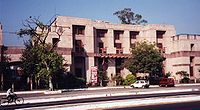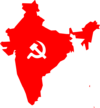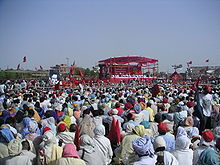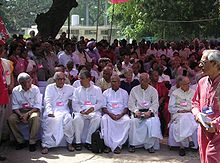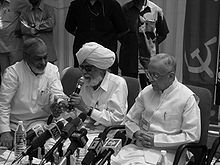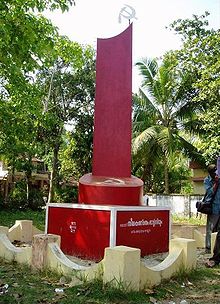- Communist Party of India (Marxist)
-
"CPIM" redirects here. For other uses, see CPIM (disambiguation).
Communist Party of India (Marxist) 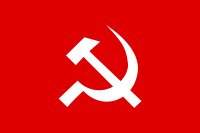
Secretary-General Prakash Karat Leader in Lok Sabha Basudev Acharia[1] Leader in Rajya Sabha Sitaram Yechuri[1] Founded 1964 Headquarters New Delhi, India Newspaper People's Democracy (English),
Lok Lehar (Hindi),
Ganashakti (Bengali),
Daily Desher Katha (Bengali),
Deshabhimani (Malayalam),
Theekathir (Tamil)Student wing Students Federation of India Youth wing Democratic Youth Federation of India Women's wing All India Democratic Womens Association Labour wing Centre of Indian Trade Unions Peasant's wing All India Kisan Sabha Ideology Communism
Marxism-LeninismECI Status Recognised Party Alliance Left Front Seats in Lok Sabha 16 / 545Seats in Rajya Sabha 15 / 250Election symbol 
Website Official Website Politics of India
Political parties
ElectionsThe Communist Party of India (Marxist) (abbreviated CPI(M) or CPM) is a political party in India. It has a strong presence in the states of Kerala, West Bengal and Tripura. As of 2011, CPI(M) is leading the state government in Tripura. It leads the Left Front coalition of leftist parties in various states and the national parliament of India. The party emerged out of a split from the Communist Party of India in 1964. CPI(M) claimed to have 1,042,287 members in 2009.[2]
Contents
History
Split in the Communist Party of India and formation of CPI (M)
Communist Party of India (Marxist)
AKG Bhavan, the CPI(M) national headquarters in Delhi 28°37′53.6″N 77°12′17.9″E / 28.631556°N 77.204972°E.Bengali mural for the CPI(M) candidate in the Kolkata North West constituency in the 2004 Lok Sabha election, Sudhangshu Seal.CPI(M) emerged out of a division within the Communist Party of India (CPI). The undivided CPI had experienced a period of upsurge during the years following the Second World War. The CPI led armed rebellions in Telangana, Tripura and Kerala. However, it soon abandoned the strategy of armed revolution in favour of working within the parliamentary framework. In 1950 B.T. Ranadive, the CPI general secretary and a prominent representative of the radical sector inside the party, was demoted on grounds of left-adventurism.
Under the government of the Indian National Congress party of Jawaharlal Nehru, independent India developed close relations and a strategic partnership with the Soviet Union. The Soviet government consequently wished that the Indian communists moderate their criticism towards the Indian state and assume a supportive role towards the Congress governments. However, large sections of the CPI claimed that India remained a semi-feudal country, and that class struggle could not be put on the back-burner for the sake of guarding the interests of Soviet trade and foreign policy. Moreover, the Indian National Congress appeared to be generally hostile towards political competition. In 1959 the central government intervened to impose President's Rule in Kerala, toppling the E.M.S. Namboodiripad cabinet (the sole non-Congress state government in the country).
Simultaneously, the relations between the Communist Party of the Soviet Union and the Communist Party of China soured. In the early 1960s the Communist Party of China began criticising the CPSU of turning revisionist and of deviating from the path of Marxism-Leninism. Sino-Indian relations also deteriorated, as border disputes between the two countries erupted into the Sino-Indian war of 1962.
Communism in India Communist Party of India
AITUC - AIKS - AIYF
AISF - NFIW - BKMUCommunist Party of India (Marxist)
Communist Ghadar Party of India
Naxalbari uprising
Communist Party of India (M-L)
Liberation - New Democracy
Janashakti - PCC - 2nd CC
Red Flag - Class Struggle
Communist Party of India (Maoist)Socialist Unity Centre of India (Communist)
AIUTUC - AIMSS
AIDYO - AIDSOM. N. Roy
Abani Mukherji
A. K. Gopalan
P. Krishna Pillai
P. C. Joshi
P. Sundarayya
Ajoy Ghosh
K. Damodaran
E. M. S. Namboodiripad
Chandra Rajeshwar Rao Azhikodan Raghavan
Bhupesh Gupta V. S. Achuthanandan
E. K. Nayanar
Guru Radha Kishan
B. T. Ranadive
Charu Majumdar
Jyoti Basu
S. A. Dange
Shibdas Ghosh
E. K. Imbichi Bava
T. Nagi ReddyTebhaga movement
CCOMPOSA
Telangana Rebellion
Comrades Association
Communist Party of French IndiaCommunism
World Communist MovementCommunism Portal
During the war with China, a faction of the Indian Communists backed the position of the Indian government, while other sections of the party claimed that it was a conflict between a socialist and a capitalist state. Hundreds of CPI leaders, accused of being pro-Chinese, were imprisoned. Some of the nationalists were also imprisoned, as they used to express their opinion only in party forums, and CPI's official stand was pro-China. Thousands of Communists were detained without trial.[3] Those targeted by the state accused the pro-Soviet leadership of the CPI of conspiring with the Congress government to ensure their own hegemony over the control of the party.In 1962 Ajoy Ghosh, the general secretary of the CPI, died. After his death, S.A. Dange was installed as the party chairman (a new position) and E.M.S. Namboodiripad as general secretary. This was an attempt to achieve a compromise. Dange represented the rightist faction of the party and E.M.S. the leftist faction.
At a CPI National Council meeting held on April 11, 1964, 32 Council members walked out in protest, accusing Dange and his followers of "anti-unity and anti-Communist policies".[4]
The leftist section, to which the 32 National Council members belonged, organised a convention in Tenali, Andhra Pradesh July 7 to 11. In this convention the issues of the internal disputes in the party were discussed. 146 delegates, claiming to represent 100,000 CPI members, took part in the proceedings. The convention decided to convene the 7th Party Congress of CPI in Calcutta later the same year.[5]
Marking a difference from the Dangeite sector of CPI, the Tenali convention was marked by the display of a large portrait of the Chinese Communist leader Mao Zedong.[5]
At the Tenali convention a Bengal-based pro-Chinese group, representing one of the most radical streams of the CPI left wing, presented a draft programme proposal of their own. These radicals criticised the draft programme proposal prepared by M. Basavapunniah for undermining class struggle and failing to take a clear pro-Chinese position in the ideological conflict between the CPSU and CPC.[6]
After the Tenali convention the CPI left wing organised party district and state conferences. In West Bengal, a few of these meetings became battlegrounds between the most radical elements and the more moderate leadership. At the Calcutta Party District Conference an alternative draft programme was presented to the leadership by Parimal Das Gupta (a leading figure amongst far-left intellectuals in the party). Another alternative proposal was brought forward to the Calcutta Party District Conference by Azizul Haque, but Haque was initially banned from presenting it by the conference organisers. At the Calcutta Party District Conference 42 delegates opposed M. Basavapunniah’s official draft programme proposal.
At the Siliguri Party District Conference, the main draft proposal for a party programme was accepted, but with some additional points suggested by the far-left North Bengal cadre Charu Majumdar. However, Harekrishna Konar (representing the leadership of the CPI left wing) forbade the raising of the slogan Mao Tse-Tung Zindabad (Long live Mao Tse-Tung) at the conference.
Parimal Das Gupta's document was also presented to the leadership at the West Bengal State Conference of the CPI leftwing. Das Gupta and a few other spoke at the conference, demanding the party ought to adopt the class analysis of the Indian state of the 1951 CPI conference. His proposal was, however, voted down.[7]
The Calcutta Congress was held between October 31 and November 7, at Tyagraja Hall in southern Calcutta. Simultaneously, the Dange group convened a Party Congress of CPI in Bombay. Thus, the CPI divided into two separate parties. The group which assembled in Calcutta would later adopt the name 'Communist Party of India (Marxist)', in order to differentiate themselves from the Dange group. The CPI(M) also adopted its own political programme. P. Sundarayya was elected general secretary of the party.
In total 422 delegates took part in the Calcutta Congress. CPI(M) claimed that they represented 104,421 CPI members, 60% of the total party membership.
At the Calcutta conference the party adopted a class analysis of the character of the Indian state, that claimed the Indian big bourgeoisie was increasingly collaborating with imperialism.[8]
Parimal Das Gupta’s alternative draft programme was not circulated at the Calcutta conference. However, Souren Basu, a delegate from the far-left stronghold Darjeeling, spoke at the conference asking why no portrait had been raised of Mao Tse-Tung along the portraits of other communist stalwarts. His intervention met with huge applauses from the delegates of the conference.[8]
Name
CPI(M) is officially known as भारत की कम्युनिस्ट पार्टी मार्क्सवादी(Bharat ki Kamyunist Party Marksvadi) in hindi, but it is often known as मार्क्सवादी कम्युनिस्ट पार्टी (Marksvadi Kamyunist Party, abbreviated MaKaPa) in press and media circles. This name though has a very interesting story to tell. During its initial years after the split, the party was often referred by different names such as 'Left Communist Party' or 'Communist Party of India(Left)'. The party has used the name 'Left' because CPI people were dubbed as rightist in nature for their support to Congress-Nehru regime. During Kerala Legislative Assembly elections of 1965 the party has adopted the name 'Communist Party of India(Marxist)' in order to obtain its election symbol from the Election Commission of India.[9]
Early years of CPI (M)
The CPI (M) was born into a hostile political climate. At the time of the holding of its Calcutta Congress, large sections of its leaders and cadres were jailed without trial. Again on December 29–30, over a thousand CPI (M) cadres were arrested, and held in jail without trial. In 1965 new waves of arrests of CPI(M) cadres took place in West Bengal, as the party launched agitations against the rise in fares in the Calcutta Tramways and against the then prevailing food crisis. State-wide general strikes and hartals were observed on August 5, 1965, March 10–11, 1966 and April 6, 1966. The March 1966 general strike results in several deaths in confrontations with police forces.
Also in Kerala, mass arrests of CPI(M) cadres were carried out during 1965. In Bihar, the party called for a Bandh (general strike) in Patna on August 9, 1965 in protest against the Congress state government. During the strike, police resorted to violent actions against the organisers of the strike. The strike was followed by agitations in other parts of the state.
P. Sundaraiah, after being released from jail, spent the period of September 1965-February 1966 in Moscow for medical treatment. In Moscow he also held talks with the CPSU.[10]
The Central Committee of CPI(M) held its first meeting on June 12–19, 1966. The reason for delaying the holding of a regular CC meeting was the fact that several of the persons elected as CC members at the Calcutta Congress were jailed at the time.[11] A CC meeting had been scheduled to have been held in Trichur during the last days of 1964, but had been cancelled due to the wave of arrests against the party. The meeting discussed tactics for electoral alliances, and concluded that the party should seek to form a broad electoral alliances with all non-reactionary opposition parties in West Bengal (i.e. all parties except Jan Sangh and Swatantra Party). This decision was strongly criticised by the Communist Party of China, the Party of Labour of Albania, the Communist Party of New Zealand and the radicals within the party itself. The line was changed at a National Council meeting in Jullunder in October 1966, were it was decided that the party should only form alliances with selected left parties.[12]
Naxalbari uprising
At this point the party stood at crossroads. There were radical sections of the party who were wary of the increasing parliamentary focus of the party leadership, especially after the electoral victories in West Bengal and Kerala. Developments in China also affected the situation inside the party. In West Bengal two separate internal dissident tendencies emerged, which both could be identified as supporting the Chinese line.[13] In 1967 a peasant uprising broke out in Naxalbari, in northern West Bengal. The insurgency was led by hardline district-level CPI(M) leaders Charu Majumdar and Kanu Sanyal. The hardliners within CPI(M) saw the Naxalbari uprising as the spark that would ignite the Indian revolution. The Communist Party of China hailed the Naxalbari movement, causing an abrupt break in CPI(M)-CPC relations.[14] The Naxalbari movement was violently repressed by the West Bengal government, of which CPI(M) was a major partner. Within the party, the hardliners rallied around an All India Coordination Committee of Communist Revolutionaries. Following the 1968 Burdwan plenum of CPI(M) (held on April 5–12, 1968), the AICCCR separated themselves from CPI(M). This split divided the party throughout the country. But notably in West Bengal, which was the centre of the violent radicalist stream, no prominent leading figure left the party. The party and the Naxalites (as the rebels were called) were soon to get into a bloody feud.
In Andhra Pradesh another revolt was taking place. There the pro-Naxalbari dissidents had not established any presence. But in the party organisation there were many veterans from the Telangana armed struggle, who rallied against the central party leadership. In Andhra Pradesh the radicals had a strong base even amongst the state-level leadership. The main leader of the radical tendency was T. Nagi Reddy, a member of the state legislative assembly. On June 15, 1968 the leaders of the radical tendency published a press statement outlining the critique of the development of CPI(M). It was signed by T. Nagi Reddy, D.V. Rao, Kolla Venkaiah and Chandra Pulla Reddy.[15] In total around 50% of the party cadres in Andhra Pradesh left the party to form the Andhra Pradesh Coordination Committee of Communist Revolutionaries, under the leadership of T. Nagi Reddy.[16]
Dismissal of United Front governments in West Bengal and Kerala
In November 1967, the West Bengal United Front government was dismissed by the central government. Initially the Indian National Congress formed a minority government led by Prafulla Chandra Ghosh, but that cabinet did not last long. Following the proclamation that the United Front government had been dislodged, a 48-hour hartal was effective throughout the state. After the fall of the Ghosh cabinet, the state was but under President's Rule. CPI(M) launched agitations against the interventions of the central government in West Bengal.
The 8th Party Congress of CPI(M) was held in Cochin, Kerala, on December 23–29, 1968. On December 25, 1968, whilst the congress was held, 42 Dalits were burned alive in the Tamil village of Kilavenmani. The massacre was a retaliation from landlords after Dalit labourers had taken part in a CPI(M)-led agitation for higher wages.[17][18]
The United Front government in Kerala was forced out of office in October 1969, as the CPI, RSP, KTP and Muslim League ministers resigned. E.M.S. Namboodiripad handed in his resignation on October 24.[19] A coalition government led by CPI leader C. Achutha Menon was formed, with the outside support of the Indian National Congress.
Elections in West Bengal and Kerala
Fresh elections were held in West Bengal in 1969. CPI(M) contested 97 seats, and won 80. The party was now the largest in the West Bengal legislative.[20] But with the active support of CPI and the Bangla Congress, Ajoy Mukherjee was returned as Chief Minister of the state. Mukherjee resigned on March 16, 1970, after a pact had been reached between CPI, Bangla Congress and the Indian National Congress against CPI(M). CPI(M) strove to form a new government, instead but the central government put the state under President's Rule.
In Kerala fresh elections were held in 1970. CPI(M) contested 73 seats and won 29. After the election Achutha Menon formed a new ministry, including ministers from the Indian National Congress.
Formation of CITU
Following the 1964 split, CPI(M) cadres had remained active with the All India Trade Union Congress. But as relations between CPI and CPI(M) soured, with the backdrop of confrontations in West Bengal and Kerala, a split also surfaced in the AITUC. In December 1969, eight CPI(M) members walked out of an AITUC Working Committee meeting. The eight called for an All India Trade Union Convention, which was held in Goa April 9–10, 1970. The convention decided that an All India Trade Union Conference be held on May 28–31 in Calcutta. The Calcutta conference would be the founding conference of the Centre of Indian Trade Unions, a new pro-CPI(M) trade union movement.[21]
Outbreak of war in East Pakistan
In 1971 Bangladesh (formerly East Pakistan) declared its independence from Pakistan. The Pakistani military tried to quell the uprising. India intervened militarily and gave active backing to the Bangladeshi resistance. Millions of Bangladeshi refugees sought shelter in India, especially in West Bengal.
At the time the radical sections of the Bangladeshi communist movement was divided into many factions. Whilst the pro-Soviet Communist Party of Bangladesh actively participated in the resistance struggle, the pro-China communist tendency found itself in a peculiar situation as China had sided with Pakistan in the war. In Calcutta, where many Bangladeshi leftists had sought refuge, CPI(M) worked to coordinate the efforts to create a new political organization. In the fall of 1971 three small groups, which were all hosted by the CPI(M), came together to form the Bangladesh Communist Party (Leninist). The new party became the sister party of CPI(M) in Bangladesh.[22]
Party organization
CPI(M) got 5.66% of votes polled in last parliamentary election (May 2004) and it has 43 MPs. It won 42.31% on an average in the 69 seats it contested. It supported the new Indian National Congress-led United Progressive Alliance government, but without becoming a part of it. On 9 July 2008 it formally withdrew support from the UPA government explaining this by differences about the Indo-US nuclear deal and the IAEA Safeguards Agreement in particular.[23]
In West Bengal and Tripura it participates in the Left Front. In Kerala the party is part of the Left Democratic Front. In Tamil Nadu it was part of the ruling Democratic Progressive Alliance led by the Dravida Munnetra Kazhagam (DMK). However, it has since withdrawn support.
Its members in Great Britain are in the electoral front Unity for Peace and Socialism with the Communist Party of Britain and the British domiciled sections of the Communist Party of Bangladesh and the Communist Party of Greece (KKE). It is standing 13 candidates in the London-wide list section of the London Assembly elections in May 2008.[24]
The structure
- The Politburo (PB)
- The Central Committee (CC)
- State Committees
- District Committees
Membership
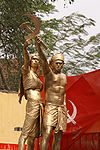 A tableaux in a CPI(M) rally in Kerala, India showing two farmers forming the hammer and sickle, the most famous communist symbol.
A tableaux in a CPI(M) rally in Kerala, India showing two farmers forming the hammer and sickle, the most famous communist symbol.
As of 2004, the party claimed a membership of 867 763.[25]
State 2001 2002 2003 2004 % of party
members in
electorateAndhra Pradesh 40785 41879 45516 46742 0.0914 Assam 10480 11207 11122 10901 0.0726 Andaman & Nicobar 172 140 124 90 0.0372 Bihar 17672 17469 16924 17353 0.0343 Chhattisgarh 1211 1364 1079 1054 0.0077 Delhi 1162 1360 1417 1408 0.0161 Goa 172 35 40 67 0.0071 Gujarat 2799 3214 3383 3398 0.0101 Haryana 1357 1478 1477 1608 0.0131 Himachal Pradesh 1005 1006 1014 1024 0.0245 Jammu & Kashmir 625 720 830 850 0.0133 Jharkhand 2552 2819 3097 3292 0.0200 Karnataka 6574 7216 6893 6492 0.0168 Kerala 301562 313652 318969 316305 1.4973 Madhya Pradesh 2243 2862 2488 2320 0.0060 Maharashtra 8545 9080 9796 10256 0.0163 Manipur 340 330 270 300 0.0195 Orissa 3091 3425 3502 3658 0.0143 Punjab 14328 11000 11000 10050 0.0586 Rajasthan 2602 3200 3507 3120 0.0090 Sikkim 200 180 65 75 0.0266 Tamil Nadu 86868 90777 91709 94343 0.1970 Tripura 38737 41588 46277 51343 2.5954 Uttaranchal 700 720 740 829 0.0149 Uttar Pradesh 5169 5541 5477 5877 0.0053 West Bengal 245026 262882 258682 274921 0.579 CC staff 96 95 95 87 Total 796073 835239 843896 867763 0.1292 Leadership
The current general secretary of CPI(M) is Prakash Karat. The 19th party congress of CPI(M), held in Coimbatore March 29-April 3, 2008 elected a Central Committee with 87 members. The Central Committee later elected a 15-member Politburo:
- Prakash Karat
- Sitaram Yechury
- S. Ramachandran Pillai
- Buddhadeb Bhattacharya
- Manik Sarkar
- M.K. Pandhe
- Biman Bose
- Pinarayi Vijayan
- K. Varadarajan
- B.V. Raghavulu
- Brinda Karat
- Nirupam Sen
- Kodiyeri Balakrishnan
- Mohammad Amin
The senior most member, V.S. Achuthanandan was removed from the Polit Bureau on July 12, 2009.
The 19th congress saw the departure of the last two members of the Polit Bureau who had been on the original Polit Bureau in 1964, Harkishen Singh Surjeet and Jyoti Basu.[26]
State Committee secretaries
- Andaman & Nicobar: K.G. Das
- Andhra Pradesh: B.V. Raghavulu
- Assam: Uddhab Barman
- Bihar: Vijaykant Thakur
- Chattisgarh: M.K. Nandi
- Delhi: P.M.S. Grewal
- Goa: Thaelman Perera
- Haryana: Inderjit Singh
- Jharkhand: J.S. Majumdar
- Karnataka: V.J.K. Nair
- Kerala : Pinarayi Vijayan
- Madhya Pradesh: Badal Saroj
- Maharashtra: Ashok Dhawale
- Orissa: Janardan Pati
- Punjab: Charan Singh Virdi(Acting)
- Rajasthan: Vasudev Sharma
- Sikkim: Balram Adhikari
- Tamil Nadu: G.Ramakrishnan
- Tripura: Bijan Dhar
- Uttaranchal: Vijai Rawat
- Uttar Pradesh: S.P. Kashyap
- West Bengal: Biman Bose[27]
The principal mass organizations of CPI(M)
- Democratic Youth Federation of India
- Students Federation of India
- Centre of Indian Trade Unions class organisation
- All India Kisan Sabha peasants' organization
- All India Agricultural Workers Union
- All India Democratic Women's Association
- Bank Employees Federation of India
- All India Lawyers Union
In Tripura, the Ganamukti Parishad is a major mass organization amongst the tribal peoples of the state. In Kerala the Adivasi Kshema Samithi, a tribal organisation is controlled by CPI(M).
This apart, on the cultural front as many as 12 major organisations are led by CPI(M).
Party publications
From the Centre, two weekly newspapers are published, People's Democracy (English) and Lok Lehar (Hindi). The central theoretical organ of the party is The Marxist, published quarterly in English.
Daily newspapers
- Ganashakti (West Bengal, Bengali)
- Deshabhimani (Kerala, Malayalam)
- Daily Desher Katha (Tripura, Bengali)
- Theekkathir (Tamil Nadu, Tamil)
- Prajasakti (Andhra Pradesh, Telugu)
Weeklies
- Abshar (West Bengal, Urdu)
- Swadhintha (West Bengal, Hindi)
- Desh Hiteshi (Bengali)
- Janashakthi (Karnataka, Kannada)[28]
- Jeevan Marg (Maharashtra, Marathi)
- Samyabadi (Orissa, Oriya)
- Deshabhimani Vaarika. (Kerala, Malayalam)
- Ganashakti (Assamese, Assam)
Fortnightlies
- Lok Jatan (Madhya Pradesh, Hindi)
- Lok Samvad (Uttar Pradesh, Hindi)
- Sarfarosh Chintan (Gujarat, Gujarati)
Monthlies
- Samajik Nayaya Saamachar (hindi and english)
- Yeh Naya Raste (Jammu & Kashmir, Urdu)
- Lok Lahar (Punjabi)
- Nandan (Bengali)
- Marxist (Tamil language)
Theoretical publications
Publishing houses
- Leftword Publication
- CPI(M) Publication
- National Book Agency (West Bengal)
- Chinta Publication (Kerala)
- Prajasakti Book House (Andhra Pradesh)
- Deshabhimani Book House (Kerala)
- Natun Sahitya Parishad (Assam)
State governments
As of 2011, CPI(M) heads the state government in Tripura. Manik Sarkar is a chief minister belonging to the party. In Tripura, the party has a majority of its own in the state assemblies, but governs together with Left Front partners.
Splits and offshoots
Main article: Various Communist/Leftist Parties in IndiaA large number of parties have been formed as a result of splits from the CPI(M), such as Communist Party of India (Marxist-Leninist), Marxist Communist Party of India, Marxist Coordination Committee in Jharkhand, Janathipathiya Samrakshana Samithy, Communist Marxist Party and BTR-EMS-AKG Janakeeya Vedi in Kerala, Party of Democratic Socialism in West Bengal, Janganotantrik Morcha in Tripura, the Ram Pasla group in Punjab, Orissa Communist Party in Orissa, etc.
Elections
Main article: CPI(M) election resultsLok-Sabha Elections
1967 General Election
1967 CPI(M) election results (seats won / seats contested / seats total / votes / % of total vote) Lok Sabha: 19 / 59 / 520 / 6246522 / 4.28% Elections to State Legislative Assemblies: Andhra Pradesh 9 / 83 / 287 / 1053855 / 7.61% Assam 0 / 14 / 126 / 61165 / 1.97% Bihar 4 / 32 / 318 / 173656 / 1.28% Haryana 0 / 8 / 81 / 16379 / 0.54% Himachal Pradesh 0 / 6 / 60 / 3019 / 0.39% Kerala 52 / 59 / 133 / 1476456 / 23.51% Madhya Pradesh 0 / 9 / 296 / 20728 / 0.23% Maharashtra 1 / 11 / 270 / 145083 / 1.08% Manipur 0 / 5 / 30 / 2093 / 0.67% Mysore 1 / 10 / 216 / 82531 / 1.10% Orissa 1 / 10 / 140 / 46597 / 1.16% Punjab 3 / 13 / 104 / 138857 / 3.26% Rajasthan 0 / 22 / 184 / 79826 / 1.18% Tamil Nadu 11 / 22 / 234 / 623114 / 4.07% Tripura 2 / 16 / 30 / 93739 / 21.61% Uttar Pradesh 1 / 57 / 425 / 272565 / 1.27% West Bengal 43 / 135 / 280 / 2293026 / 18.11% In the 1967 Lok Sabha elections CPI(M) nominated 59 candidates. In total 19 of them were elected. The party received 6.2 million votes (4.28% of the nationwide vote). By comparison, CPI won 23 seats and got 5.11% of the nation-wide vote. In the state legistative elections held simultaneously, the CPI(M) emerged as a major party in Kerala and West Bengal. In Kerala a United Front government led by E.M.S. Namboodiripad was formed.[29] In West Bengal, CPI(M) was the main force behind the United Front government formed. The Chief Ministership was given to Ajoy Mukherjee of the Bangla Congress (a regional splinter-group of the Indian National Congress).
1971 General Election
With the backdrop of the Bangladesh War and the emerging role of Indira Gandhi as a populist national leader, the 1971 election to the Lok Sabha was held. CPI(M) contested 85 seats, and won in 25. In total the party mustered 7510089 votes (5.12% of the national vote). 20 of the seats came from West Bengal (including Somnath Chatterjee, elected from Burdwan), 2 from Kerala (including A.K. Gopalan, elected from Trichur), 2 from Tripura (Biren Dutta and Dasarath Deb) and 1 from Andhra Pradesh.[30]
In the same year, state legislative elections were held in three states; West Bengal, Tamil Nadu and Orissa. In West Bengal CPI(M) had 241 candidates, winning 113 seats. In total the party mustered 4241557 votes (32.86% of the state-wide vote). In Tamil Nadu CPI(M) contested 37 seats, but drew blank. The party got 259298 votes (1.65% of the state-wide vote). In Orissa the party contested 11 seats, and won in two. The CPI(M) vote in the state was 52785 (1.2% of the state-wide vote).[31]
1977 General Elections
In the 1977 Loksabha elections the CPM had fielded its candidates on 53 seats scattred around in 14 states and union terretories of India. It won 4.29% of the average votes polled in this election. The party had won 17 seats from West Bengal, 3 from Maharashtra and one each from Orrissa and Punjab. This election was done shortly after the Emergency imposed by the Indira Gandhi and reflected a wide uproar of masses against her draconian rule. An coalition of Opposition parties was formed against the Congress regime, CPI(M) too supported this coalition by not fielding its candidates against the Janta Party.[32]
1980 General Elections
Janta Party coalition didnot last much and two years after since its formation India had faced the 1980s Loksabha Elections. This election had saw an increase in the vote percentage of CPI(M) and the party had bagged more seats then the previous elections. The Party had contested elections in the 15 states and union terretories of India, and fielded its candidates on 64 seats. The party had successfully won 37 seats in total. It has one 28 seats in West Bengal, 7 in Kerala, and 2 seats in Tripura. The party emerged out as the whole sole representative of the people of Tripura in this election.[33]
State Assembly Elections
1970s, 1980s, 1990s
In the 1977 election, the CPI(M) gained the majority in the Legislative Assembly of the State of West Bengal, defeating the Congress (I). Jyoti Basu became the chief minister of West Bengal, an office he held until his retirement in 2000. The CPI(M) held the majority in the West Bengal government continuously since 1977, which ended in 2011 election.The party also won in Tripura winning 49 of the 60 seats. It has 3 MLAs in Rajasthan assembly. In Bihar it has an alliance with CPI(ML)L and CPI, it has 1 seat in Andhra Pradesh. In Tamil Nadu it has worked for Dalit causes.
Presidential Elections
2002 Presidential Elections
In the 2002 Presidential elections, Left Front has announced Captain Lakshmi Sehgal as their Presidential Candidate. Against her was the ruling Bharatiya Janata Party's Candidate APJ Abdul Kalam.[34] CPIM's Leadership has announced that in form of Captain Lakshmi, they are fielding an 'Alternative Candidate'. They said that though it is clear that Captain Lakshmi cant be the President of India because of the opposition of BJP led NDA and Indian National Congress to her, but through this Presidential Election Left wants to raise key national issues, and make them heard to the masses.[35] Captain Lakshmi herself had pointed out that this Presidential election reflects the opposition of the Indian Left to the Communal-Secreterian Politics of BJP and solidarity with the religious minorities who have suffered a lot under the National Democratic Alliance's leadership.[36]
Captain Lakshmi Sehgal was an Indian Freedom Fighter, who had served as a Commander in the Indian National Army of Netaji Subhash Chandra Bose.2011 Assembly Elections
The CPI(M) led coalitions lost the assembly elections in Kerala and West Bengal. In Kerala, CPI(M) led Left Democratic Front coalition with 68 seats lost to Indian National Congress led United Democratic Front's 72 seats in a neck to neck fought assembly elections. In West Bengal, CPI(M) alliance with 62 seats suffered a setback after 34 years of continuous rule, losing to Trinamool Congress alliance's 226 seats. Its Chief Minister candidate who is also an incumbent Chief Minister, Buddhadeb Bhattacharjee also lost from his Jadavpur assembly constituency.[37]
CPI(M) leader and former Chief Minister of Kerala, V.S. Achuthanandan has stated in a TV interview that Bengal defeat was "because of the deviation from party policies and because of its anti-peasant line. Though party tried to correct the mistakes, is not effective enough prevent the downturn." Former CPI(M) leader and prominent economist Ashok Mitra pointed out that the reason why Left Front got defeated in West Bengal is, among other things, the present state leaders deviated from communist policies and principles.[38] There is a criticism that Budhadeb and Nirupam Sen were working as Corporate agents and was influenced by Neo-Liberal policies. CAG had earlier stated in its report that by allocating land to TATA at a subsidized rate, West Bengal govt incurred losses to the public exchequer. Former minister and CPI(M) leader Abdur Rezzak Mollah, blamed politburo members Buddhadeb Bhattacharjee and Nirupam Sen for the Left Front debacle in the Bengal assembly elections. [39]Wikileaks documents published in "The Hindu" newspaper reveals that Budhadeb had assured US Diplomats that, if CPI(M) refused to approve neo-liberal policies, the party should perish.[40] According to media reports Budhadeb rarely attended Polit Bureau meetings, and he had spent more time discussing with Manmohan Singh and Corporate lobbies than with his own party leaders.
See also
- Communist Ghadar Party of India
- List of political parties in India
- Politics of India
- List of Communist Parties
- Election Results of Communist Party of India (Marxist)
- Co-ordinating Committee of Communist Parties in Britain
- List of Communist Parties in India
References
- ^ a b http://cpim.org/content/pr-dasmunshis-statement
- ^ "About Us". http://cpim.org/content/about-us.
- ^ The bulk of the detainees came from the leftwing of CPI. However, cadres of the Socialist Unity Centre of India and the Workers Party of India were also targeted.[1]
- ^ The 32 were P. Sundarayya, M. Basavapunniah, T. Nagi Reddy, M. Hanumantha Rao, D.V. Rao, N. Prasad Rao, G. Bapanayya, E.M.S. Namboodiripad, A.K. Gopalan, A.V. Kunhambu, C.H. Kanaran, E.K. Nayanar, V.S. Achuthanandan Removed, E.K. Imbichibava, Promode Das Gupta, Muzaffar Ahmad, Jyoti Basu, Abdul Halim, Hare Krishna Konar, Saroj Mukherjee, P. Ramamurthi, M.R. Venkataraman, N. Sankariah, K. Ramani, Harkishan Singh Surjeet, Jagjit Singh Lyallpuri, D.S. Tapiala, Dr. Bhag Singh, Sheo Kumar Mishra, R.N. Upadhyaya, Mohan Punamiya and R.P. Saraf. Source: Bose, Shanti Shekar; A Brief Note on the Contents of Documents of the Communist Movement in India. Kolkata: 2005, National Book Agency, p. 37.
- ^ a b Basu, Pradip. Towards Naxalbari (1953-1967) – An Account of Inner-Party Ideological Struggle. Calcutta: Progressive Publishers, 2000. p. 51.
- ^ Suniti Kumar Ghosh was a member of the group that presented this alternative draft proposal. His grouping was one of several left tendencies in the Bengali party branch. Basu, Pradip. Towards Naxalbari (1953-1967) – An Account of Inner-Party Ideological Struggle. Calcutta: Progressive Publishers, 2000. p. 32.
- ^ Basu, Pradip. Towards Naxalbari (1953-1967) – An Account of Inner-Party Ideological Struggle. Calcutta: Progressive Publishers, 2000. p. 52-54.
- ^ a b Basu, Pradip. Towards Naxalbari (1953-1967) – An Account of Inner-Party Ideological Struggle. Calcutta: Progressive Publishers, 2000. p. 54.
- ^ Basu, Jyoti. Memoirs - A Political Autobiography. Calcutta: National Book Agency, 1999. p. 189.
- ^ M.V.S. Koteswara Rao. Communist Parties and U./nited Front - Experience in Kerala and West Bengal. Hyderabad: Prajasakti Book House, 2003. p. 17-18
- ^ The jailed members of the new CC, at the time of the Calcutta Congress, were B.T. Ranadive, Muzaffar Ahmed, Hare Krishna Konar and Promode Das Gupta. Source: Bose, Shanti Shekar; A Brief Note on the Contents of Documents of the Communist Movement in India. Kolkata: 2005, National Book Agency, p. 44-5.
- ^ M.V.S. Koteswara Rao. Communist Parties and United Front - Experience in Kerala and West Bengal. Hyderabad: Prajasakti Book House, 2003. p. 234-235.
- ^ According to Basu (in Basu, Pradip; Towards Naxalbari (1953–67) : An Account Of Inner-Party Ideological Struggle. Calcutta: Progressive Publishers, 2000.) there were two nuclei of radicals in the party organisation in West Bengal. One "theorist" section around Parimal Das Gupta in Calcutta, which wanted to persuade the party leadership to correct revisionist mistakes through inner-party debate, and one "actionist" section led by Charu Majumdar and Kanu Sanyal in North Bengal. The 'actionists' were impatient, and strived to organize armed uprisings. According to Basu, due to the prevailing political climate of youth and student rebellion it was the 'actionists' which came to dominate the new Maoist movement in India, instead of the more theoretically advanced sections. This dichotomy is however rebuffed by followers of the radical stream, for example the CPI(ML) Liberation.
- ^ On July 1 People's Daily carried an article titled Spring Thunder Over India, expressing the support of CPC to the Naxalbari rebels. At its meeting in Madurai on August 18–27, 1967, the Central Committee of CPI(M) adopted a resolution titled 'Resolution on Divergent Views Between Our Party and the Communist Party of China on Certain Fundamental Issues of Programme and Policy'. Source: Bose, Shanti Shekar; A Brief Note on the Contents of Documents of the Communist Movement in India. Kolkata: 2005, National Book Agency, p. 46.
- ^ This press statement was reproduced in full in the central CPI(M) publication, People's Democracy, on June 30. P. Sundarayya and M. Basavapunniah, acting on behalf of the Polit Bureau of CPI(M), formulated a response to the statement on June 16, titled 'Rebuff the Rebels, Uphold Party Unity'. Source: Bose, Shanti Shekar; A Brief Note on the Contents of Documents of the Communist Movement in India. Kolkata: 2005, National Book Agency, p. 48.
- ^ Some perceive that the Chinese leadership severely misjudged the actual conditions of different Indian factions at the time, giving their full support to the Majumdar-Sanyal group whilst keeping the Andhra Pradesh radicals (that had a considerable mass following) at distance.
- ^ Dalits and land issues
- ^ Untitled-1
- ^ officialwebsite of kerala.gov.in
- ^ Indian National Congress had won 55 seats, Bangla Congress 33 and CPI 30. CPI(M) allies also won several seats.ECI: Statistical Report on the 1969 West Bengal Legislative Election
- ^ Bose, Shanti Shekar; A Brief Note on the Contents of Documents of the Communist Movement in India. Kolkata: 2005, National Book Agency, p. 56-59
- ^ The same is also true for the Workers Party of Bangladesh, which was formed in 1980 when BCP(L) merged with other groups. Although politically close, WPB can be said to have a more Maoist-oriented profile than CPI(M).
- ^ article in The Hindu, 9 July 2008: Left meets President, hands over letter of withdrawal
- ^ Unity For Peace and Socialism homepage
- ^ Membership figures from http://www.cpim.org/pd/2005/0403/04032005_membership.htm. Electorate numbers taken from http://www.eci.gov.in/SR_KeyHighLights/LS_2004/Vol_I_LS_2004.pdf. Puducherry is counted as part of Tamil Nadu, Chandigarh counted as part of Punjab.
- ^ "Nine to none, founders’ era ends in CPM", The Telegraph (Calcutta), April 3, 2008.
- ^ List of State Secretaries
- ^ Janashakti has replaced the previous CPI(M) organ in Karnataka, Ikyaranga
- ^ In Kerala the United Front consisted, at the time of the election, of Communist Party of India (Marxist), the Communist Party of India, the Muslim League, the Revolutionary Socialist Party, the Karshaka Thozhilali Party and the Kerala Socialist Party.[2]
- ^ ECI: Statistical Report on the 1971 Lok Sabha Election
- ^ ECI: Statistical Report on the 1971 Orissa Legislative Election, ECI: Statistical Report on the 1971 Tamil Nadu Legislative Election, ECI: Statistical Report on the 1971 West Bengal Legislative Election
- ^ 1977 general elections ECI Report
- ^ 1980 General Elections ECI Report
- ^ Story in The Hindu
- ^ Sitaram Yechury on 2002 Presidential Elections
- ^ Captain Lakshmi's Interview
- ^ http://www.ndtv.com/elections/index.php
- ^ http://www.telegraphindia.com/1110520/jsp/opinion/story_13997495.jsp
- ^ http://articles.timesofindia.indiatimes.com/2011-05-18/india/29555427_1_censures-abdur-rezzak-mollah-cpm
- ^ http://www.thehindu.com/todays-paper/tp-national/article1595932.ece
Further reading
- Search For Ways To Keep Marx Alive Opinion on party structure by Sumanta Sen. The Telegraph Calcutta, India. March 31, 2005. Accessed April 1, 2005.
- Veteran Communists Honoured News article on Party history conference. The Hindu. April 6, 2005. Accessed April 8, 2005.
- All you wanted to know about CPI-M News article on CPI-M. Rediff News. April 8, 2005. Accessed April 8, 2005.
- An Upbeat Left by Venkitesh Ramakrishnan. Frontline Volume 22 - Issue 09, April 23 - May 6, 2005
External links
Categories:- Communist parties in India
- Communist Party of India breakaway groups
- Communist Party of India (Marxist)
Wikimedia Foundation. 2010.

